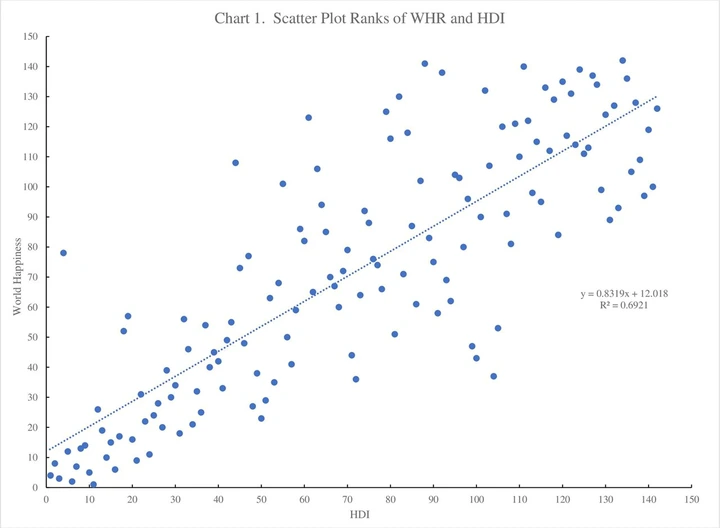
View pictures in App save up to 80% data.
Economist David Blanchflower focuses on the topic of happiness. For over twenty years, the Bruce V. Rauner 1978 Professor has authored more than 30 research papers that uncover a consistent trend in how individuals generally perceive happiness and well-being throughout their lives.
This pattern, which has been reproduced countless times by various researchers, is well-known for its representation on a U-shaped graph.
"Essentially, our research indicated that individuals experience their lowest levels of happiness during middle age. Happiness seems to be prevalent in youth and again in later years, creating a U-shaped curve," explains Blanchflower, an expert in labor economics who was part of the Monetary Policy Committee at the Bank of England from 2006 to 2009.
Recently, Blanchflower and his team have observed a concerning shift. The left side of the U—symbolizing the youth—is no longer rising. What’s behind this change? Young individuals across the globe have been expressing higher levels of dissatisfaction. Blanchflower suggests that the rise of smartphones and social media could be a significant contributing factor.
Blanchflower states that although it has only come to light recently, the change in the happiness trend actually started over ten years ago.
"The U-shaped curve was once considered a key concept in social science, but that has changed," he explains. "Our findings indicate that beginning in 2013, this U-shaped trend began to fade away. It's not that the previous observations were incorrect; rather, they evolved. We are now witnessing a global decline in the well-being of young people, particularly among young women."
What raises concerns about smartphones and social media? Since the launch of the first iPhone in 2007, the prevalence of these technologies has skyrocketed, significantly altering how individuals, particularly children, interact socially.
Blanchflower notes, "When children dedicate time to smartphones, they miss out on face-to-face interactions and the activities we, as kids, enjoyed." He adds, "Neuroscientists indicate that interpersonal interactions help our brains create crucial connections that influence social and emotional development."
He contends that the hours children dedicate to smartphones could have been better utilized in interacting with peers and fostering their cognitive development. Supporting this claim, a recent study by the Centers for Disease Control and Prevention revealed a concerning correlation: increased social media usage among high school students is linked to a higher likelihood of experiencing bullying and cyberbullying.
And Blanchflower himself recently published a paper in the International Journal of Wellbeing on how the experience of childhood traumas, including bullying, can have lifelong negative effects.
"According to Blanchflower, the repercussions of bullying can last for decades, sometimes even up to 50 years. This suggests that cyberbullying could lead to a range of detrimental outcomes. It affects various aspects of life, including educational achievements, the quality of personal relationships, and even one's earning potential."
Still, when they first noticed the change in the U-shaped graph, Blanchflower and his colleagues thought the trend might be related to major events, such as the COVID-19 pandemic or the financial crisis of 2008. But their deep dive into micro-data from major surveys in the U.S., Europe, and the U.K., among others, recently published in the journal PLOS ONE, showed that these events had only a short-term negative impact on reported well-being.
According to Blanchflower, these temporary crises generated disturbances that obscured the longer-term patterns in the data.
"We all acknowledged that COVID was a serious issue. However, what we overlooked was that COVID merely accelerated an ongoing trend that had been developing. Now, we find ourselves trying to make up for lost time as we were diverted by the pandemic and failed to recognize this persistent trend."
A noticeable decrease in the happiness and overall well-being of young people has been reported across various nations, such as the U.K., U.S., Canada, Australia, New Zealand, Scandinavian countries, the Netherlands, France, Germany, and Italy. Over the last year, Blanchflower has collaborated extensively with the United Nations to analyze global trends in mental health.
He is presently engaged in the development of multiple working papers commissioned by the UN, which examine trends in well-being among youth globally. He has already finalized studies focusing on the U.S., the U.K., Europe, Africa, and Latin America. According to him, well-being has notably decreased, particularly among young individuals who are internet users. (These papers can be accessed on Blanchflower's website.)
Certain K-12 schools have begun restricting students' use of smartphones, and Australia has recently implemented a ban on social media platforms for individuals under 16 years old.
Blanchflower emphasizes that grasping the reasons behind the trend is essential for discovering solutions to reverse it. "We must avoid creating a lost generation," he states.
He is in the process of coordinating a significant conference scheduled for October, in collaboration with the Human Development Report Office of the United Nations Development Programme. This event aims to unite experts, global policymakers, and higher education leaders to exchange research findings and effective strategies for tackling the ongoing crisis.
The symposium is set to take place at Dartmouth, where President Sian Leah Beilock has prioritized mental health significantly.
He expresses, "There is an increasing agreement that this is occurring. The discussion revolves around the causes, the extent of its spread, and the appropriate responses. This is where experts will convene to deliberate, and we will examine effective strategies from across the globe."
More information: David G. Blanchflower et al, The adult consequences on wellbeing of abuse and neglect in childhood, International Journal of Wellbeing (2024). DOI: 10.5502/ijw.v14i3.3513
David G. Blanchflower et al, Were COVID and the Great Recession well-being reducing?, PLOS ONE (2024). DOI: 10.1371/journal.pone.0305347
Supplied by Dartmouth College
This story was originally published on Medical Xpress. Subscribe to our newsletter for the latest sci-tech news updates.








